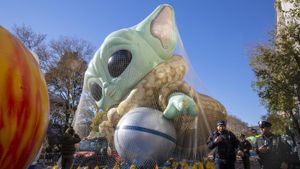A surprising turn of events is shaking up the lives of NASA astronauts Butch Wilmore and Sunita Williams, who now find themselves indefinitely stranded aboard the International Space Station (ISS). Originally intended as eight-day test mission, the complications with their Boeing Starliner spacecraft have twisted their situation, affecting not just their plans but their health and mental well-being.
The Boeing Starliner was launched on June 5, 2024, but faced significant issues shortly after docking to the ISS. Helium leaks and malfunctioning thrusters prompted NASA to postpone their safe return by potentially months, signaling urgent safety concerns.
On August 14, NASA delivered much-needed supplies to the crew aboard the ISS, including food, fuel, and equipment. This cargo, sent via the Progress 89 spacecraft, which launched from Baikonur Cosmodrome, arrived just as the astronauts began acclimatizing to their unexpected extended stay.
Experts from Western University warn about the challenges stemming from prolonged isolation and confinement. Dr. Joe Acaba, NASA's Chief Astronaut, acknowledged the psychological stresses astronauts may experience, stating, "If Butch and Suni do not come home on Starliner, they will have about eight months on orbit."
Both astronauts engage actively with life aboard the ISS, conducting scientific experiments and completing maintenance tasks. Williams and Wilmore are expected to stay productive during this extra time, working alongside the seven-person crew of Expedition 71, which includes both U.S. and Russian members.
Communication with their families back on Earth remains uninterrupted, providing them with emotional support. Wilmore frequently uses FaceTime to connect with his wife and daughters, sharing mesmerizing views of Earth from their orbiting home.
Despite the confined contexts, personal connections flourish: "He gives us lots of Earth views," shared Wilmore's daughter, Daryn. With the ISS traveling at about five miles per second and orbiting our planet every 90 minutes, there’s never a shortage of stunning visuals to share.
Family reactions to their extended missions have varied, with both spouses expressing mixed feelings about their loved ones’ extended stay. Deanna Wilmore remarked, "You just sort of have to roll with it and expect the unexpected," demonstrating her resilience through uncertainty.
On the other hand, Michael Williams noted, "That's her happy place," emphasizing how his wife enjoys her time aboard the ISS. This perspective aids their families as they adjust to this uncharted territory.
NASA continues to explore available options for safely returning the astronauts. Solutions may involve repairs to the Starliner or potentially hitching rides back on SpaceX’s Crew Dragon, which faces its own delays.
NASA officials predict the need for the astronauts to remain until February 2025 if the Starliner isn't ready. This would set the total duration of their missions near the remarkable benchmark established by prior crews who’ve spent upwards of eight months living and working on the ISS.
Health problems arise as extended stays can gravely affect astronauts. Williams faces significant challenges as her initial eight-day mission turns to months, risking not only her physical abilities but also her mental state.
Reports indicate she is contending with side effects linked to microgravity, such as bone density loss and vision impairment resulting from Spaceflight Associated Neuro-ocular Syndrome (SANS). These health risks are common among astronauts upon extended exposure to conditions beyond Earth’s environment.
Public response to the situation echoes uncertainty and empathy for both astronauts and their families. Many are drawn to the couples’ resilience and steadfast focus amid their current challenges, recognizing the sheer unpredictability of space travel.
Despite these setbacks, both Williams and Wilmore rely on their training and commitment to science. Their continued efforts are emblematic of the human spirit's capacity to adapt and thrive, even when faced with extraordinary circumstances.
NASA remains hopeful for both astronauts, already deploying contingency plans should their circumstances fail to improve. With every passing moment aboard the ISS, they explore, learn, and inspire—reminding us all of the beauty and unpredictability inherent to space exploration.



